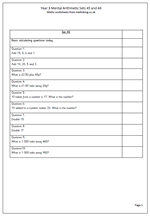It is in year 2 that children really get to grips with simple block graphs and here is one of the superb sets of year 2 maths worksheets which URBrainy.com have allowed me to publish. There are two aspects to block graphs. Firstly, interpreting a graph and understanding what it shows. Secondly, collecting suitable data to create a block graph.
This page is suitable for 6/7 year old children and looks at the favourite sandwich fillings of a class:- always a popular subject.
The first page involves interpreting the results of the graph, whilst the second page is a template which can be printed and used by the child to show the results of their own survey. It is well worth going to URBrainy as a simple log in process allows access to all their resources for a week as well as printing up to ten sets of worksheets. If you are looking for full and detailed coverage of Key Stage 1 then I can highly recommend this.









